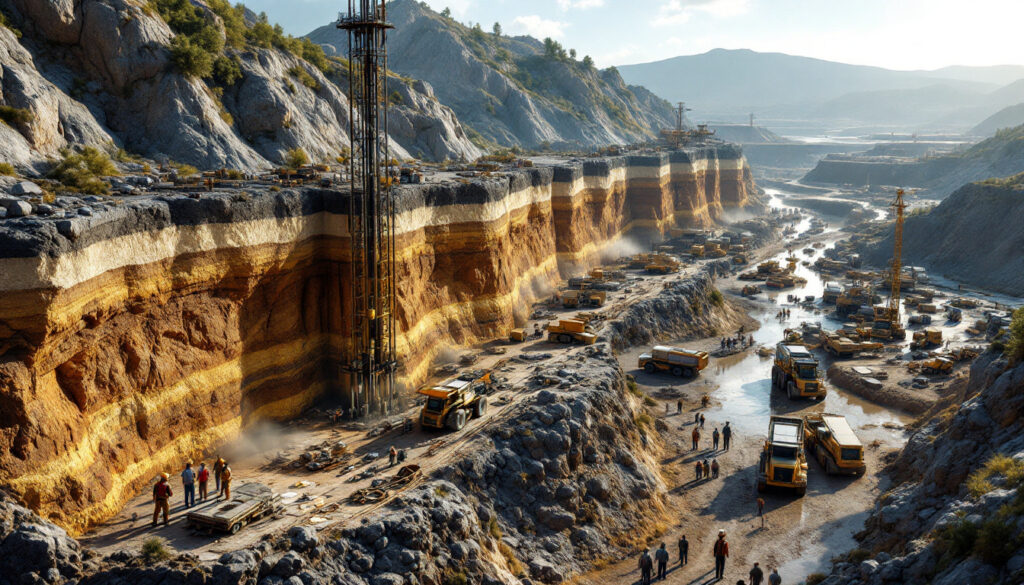The Widening Gap: Understanding Time Delay Between Discovery and Development in Mining
Mining projects follow a complex journey from initial discovery to operational mine, a pathway that has grown increasingly longer and more challenging over recent decades. This critical delay period shapes supply chains, investment decisions, and the future availability of minerals essential to modern technology. A detailed analysis reveals the factors extending these timelines and strategies mining companies employ to navigate these extended development cycles.
What Factors Influence the Conversion Rate from Discovery to Mine?
Comprehensive research by Minex Consulting analyzing 4,676 significant non-bulk mineral discoveries worldwide since 1950 reveals striking patterns that explain why some mineral finds become productive assets while others remain undeveloped for decades—or forever.
Key Discovery-to-Development Statistics
The mining industry's fundamental challenge becomes evident when examining historical conversion rates. Of those 4,676 discoveries analyzed, only 2,120 (approximately 45%) have been developed into operational mines.
This figure requires context, as many recent discoveries remain under evaluation and may eventually contribute to production. When measured by contained metal volume rather than simple discovery count, the conversion rate improves to 60-80%, indicating that the most valuable discoveries tend to reach production status more frequently.
"The average delay between discovery and development stands at 12.4 years as a nominal figure," notes Richard Schodde of Minex Consulting, "but this statistic masks a concerning trend—for recent discoveries, the true development timeframe extends to approximately 20 years in practice."
This increasing gap between finding minerals and producing them has profound implications for resource security, especially as demand for critical minerals accelerates with the green energy transition and digitalization.
Commodity-Specific Conversion Patterns
Not all minerals follow identical development pathways. Gold deposits consistently demonstrate higher conversion rates compared to base metals like copper or nickel. This disparity stems from gold's unique characteristics:
- Lower processing complexity
- Reduced capital requirements
- More accessible financing options
- Higher value-to-volume ratio
Deposit size proves decisive across all commodities. Larger deposits convert at significantly higher rates due to improved economics, with 60-80% of discovered metal (by volume) eventually reaching production. This contrasts with the 50-70% conversion rate when measured simply by deposit count, confirming that smaller deposits face steeper development hurdles.
How Has the Discovery-to-Development Timeline Changed Over Time?
Historical analysis reveals a troubling trend: the path from discovery to production has grown substantially longer, creating challenges for supply forecasting and investment planning.
Historical Trend Analysis
When tracking discovery cohorts by decade, a clear pattern emerges. Deposits discovered in the 1960s and 1970s generally progressed to production relatively quickly, with the majority becoming operational within 10-15 years.
This timeline has progressively lengthened with each subsequent decade. By the 2000s, the percentage of discoveries reaching production within comparable timeframes dropped dramatically. This trend affects all major commodities but varies in severity:
- Gold: Slowest percentage decrease in conversion rates
- Copper: Moderate decline in conversion speed
- Nickel: Most significant extension of development timeline
The cumulative data shows an unmistakable downward trajectory in conversion rates from the 1960s through the present day, with modern discoveries facing unprecedented delays before production.
Factors Extending Development Timelines
Multiple forces contribute to lengthening development cycles:
-
Technical complexity: Remaining deposits often present metallurgical challenges, deeper mineralization, or complex ore bodies requiring advanced extraction methods
-
Environmental standards: Rigorous environmental impact assessments now require comprehensive baseline studies spanning multiple seasons, detailed mitigation plans, and ongoing monitoring commitments
-
Capital intensity: Rising development costs necessitate larger investment rounds and more complex financing structures
-
Social license requirements: Community consultation processes have evolved from cursory engagement to multi-year dialogues with diverse stakeholders
-
Market volatility: Cyclical commodity markets create funding gaps during downturns, extending project timelines
-
Resource quality: Declining global ore grades require more extensive feasibility studies and pilot plant testing to confirm economic viability
These factors create a compounding effect, with each additional year of delay potentially triggering reassessments, permitting renewals, or changes in economic parameters.
What Makes Larger Deposits More Likely to Be Developed?
The data consistently shows that deposit size remains one of the strongest predictors of development success, with larger mineral discoveries demonstrating significantly higher conversion rates.
Economic Advantages of Scale
Larger deposits offer several decisive advantages:
- Capital efficiency: Fixed infrastructure costs (access roads, processing facilities, power supply) can be amortized over larger production volumes
- Operating resilience: Higher-volume operations typically achieve lower per-unit production costs
- Price volatility buffer: Higher margins provide protection during commodity price downturns
- Financing attractiveness: Institutional investors and major mining companies prioritize projects with substantial reserves supporting longer mine life
- Optimization potential: Scale allows implementation of more efficient mining methods and processing technologies
These economic factors create a significant bias toward developing larger deposits, even when smaller deposits might contain higher-grade ore.
Development Challenges for Smaller Deposits
Smaller mineral discoveries face distinct disadvantages:
- Higher unit costs: Fixed development expenses must be recovered from smaller production volumes
- Limited economies of scale: Reduced ability to implement efficient mining methods and processing technologies
- Financial constraints: Difficulty securing capital for projects with shorter projected mine lives
- Market sensitivity: Greater vulnerability to commodity price fluctuations
- Permitting proportionality: Environmental and regulatory requirements often remain similar regardless of project size
The economics of smaller deposits might improve with proximity to existing infrastructure, exceptional ore quality, or specialized market demand for specific mineral attributes. However, the general trend strongly favors larger resources.
"When evaluating the conversion rates of discoveries to mines, size consistently emerges as the dominant factor. Larger deposits, particularly those representing the top quartile by contained metal, demonstrate conversion rates 30-40% higher than smaller discoveries in the same commodity class." – Richard Schodde, Minex Consulting
How Do Development Patterns Vary by Commodity?
Different minerals follow distinct development patterns, influenced by processing requirements, market dynamics, and capital intensity.
Gold Project Development Characteristics
Gold projects typically demonstrate faster discovery-to-production timelines:
- Processing simplicity: Many gold deposits can utilize standardized extraction methods
- Modular development: Production can often begin at smaller scales and expand incrementally
- Financing accessibility: Junior mining companies can more readily secure funding for gold projects
- Market liquidity: Consistent global demand reduces offtake risk
- Value concentration: High value-to-volume ratio minimizes transportation infrastructure requirements
These advantages collectively explain why gold discoveries maintain higher conversion rates than base metals, with development timelines averaging 15-20% shorter than comparable copper projects. Despite these advantages, recent gold market performance shows increasing volatility affecting even this relatively stable sector.
Base Metal Development Challenges
Copper, nickel, zinc, and other base metal projects face more complex development pathways:
- Infrastructure intensity: Requirements for substantial power, water, and transportation infrastructure
- Processing complexity: Multi-stage concentration, smelting, and refining processes
- Capital burden: Higher upfront investment requirements before first production
- Market cycles: Greater exposure to industrial demand fluctuations
- Concentrate logistics: Transportation and treatment of intermediate products before reaching final markets
These factors create longer development timelines for base metal projects, with the gap between discovery and production frequently extending beyond two decades for recent discoveries. Recent copper price insights suggest this could further complicate development decisions.
What Are the Industry Implications of Longer Development Timelines?
The progressive lengthening of mining development timeframes creates significant challenges for the industry, commodity markets, and mineral-dependent supply chains.
Supply Chain Vulnerabilities
Extended development cycles generate strategic mineral supply risks:
- Response lag: Inability to quickly address emerging demand surges for critical minerals
- Production plateau risk: Declining output from aging mines may not be offset by new developments
- Strategic vulnerability: Nations dependent on mineral imports face increasing supply uncertainty
- Price volatility: Supply constraints during transition periods may trigger extreme price movements
- Technology metal gaps: Specialty metals critical to emerging technologies face particular supply constraints
The time delay between discovery and development in mining creates potential bottlenecks for manufacturing sectors dependent on steady mineral supplies, particularly for technology-critical elements like cobalt, lithium, rare earths, and copper. According to research from S&P Global, the average lead time for mines that started between 2010 and 2020 was 15.7 years.
Investment Considerations
Longer development cycles fundamentally alter the investment landscape:
- Extended pre-revenue periods: More years between initial capital deployment and first cash flow
- Higher cumulative costs: Carrying costs, continued studies, and maintaining permits during extended development
- Investment hesitancy: Institutional capital increasingly reluctant to fund early-stage discoveries with distant production horizons
- Valuation challenges: Difficulty applying traditional discounted cash flow models to projects with 20+ year development timelines
- Financing innovations: Emergence of alternative funding structures including streaming, royalties, and strategic partnerships
These financial implications create particular challenges for junior exploration companies, which must maintain investor interest and corporate viability during increasingly lengthy pre-development periods.
How Can Companies Navigate Longer Development Pathways?
Forward-thinking mining companies are adapting strategies to address extended development timelines while maintaining value creation.
Strategic Approaches to Expedite Development
Industry leaders employ several tactics to accelerate the path to production:
- Phased development: Starting with smaller-scale operations to generate early cash flow while proving concept
- Proactive stakeholder engagement: Beginning community consultation and environmental baseline work at exploration stage
- Strategic partnerships: Collaborating with major miners, end-users, or government entities to share development burden
- Brownfield prioritization: Focusing on discoveries near existing operations to leverage infrastructure and permitting advantages
- Technological innovation: Implementing novel processing methods that reduce capital intensity or environmental footprint
These approaches help mitigate the time-to-market challenges, though they rarely fully offset the broader trend toward longer development cycles. Understanding mineral discovery curve trends can help companies better position their projects within this extended timeline.
Risk Mitigation Strategies
Leading mining organizations also implement risk management approaches:
- Jurisdictional diversification: Maintaining project portfolios across multiple regulatory environments
- Staging decision gates: Implementing rigorous review processes before advancing to higher-investment development phases
- Optionality preservation: Structuring projects to maintain flexibility in response to changing market conditions
- Enhanced sustainability integration: Embedding environmental and social considerations from earliest project stages
- Digital transformation: Utilizing advanced modeling and simulation to identify and address potential obstacles earlier
While these strategies can't eliminate the fundamental challenges of extended development timelines, they help companies maintain financial discipline and strategic focus throughout the process. Organizations must also navigate increasingly complex mining permitting challenges that contribute significantly to development delays.
What Does This Mean for Future Mineral Supply?
The widening gap between discovery and development creates significant implications for future resource availability, particularly as demand accelerates for minerals essential to energy transition technologies.
Long-term Supply Challenges
Several concerning trends emerge when projecting current development patterns:
- Critical mineral deficits: Potential supply shortfalls for copper, nickel, cobalt, and lithium as demand growth outpaces new project development
- Recycling imperative: Increasing importance of secondary supply from recycled materials to bridge primary production gaps
- Jurisdictional premium: Growing value advantage for projects in locations with streamlined permitting processes
- Policy pressure: Rising likelihood of government intervention to accelerate development of strategically important mineral resources
- Substitution acceleration: Intensified research into alternative materials that can replace supply-constrained minerals
These factors suggest a challenging supply environment for certain minerals, with implications for manufacturing sectors dependent on reliable mineral inputs. The time delay between discovery and development in mining has increasingly significant consequences for global supply chains.
Technology and Innovation Opportunities
Extended development timelines also create opportunities for technological solutions:
- Advanced exploration technologies: Improved targeting to increase discovery success rates
- Novel processing methods: Technologies enabling economic extraction from lower-grade or complex deposits
- Digital optimization: Comprehensive digital modeling reducing study timeframes and improving development decisions
- ESG-centric innovation: Technologies addressing environmental and social barriers to faster development
- Intelligent mining systems: Automation and AI applications reducing operating costs and improving project economics
Innovation across the mining value chain represents the most promising pathway to address the growing discovery-to-development gap, potentially unlocking previously uneconomic resources while reducing environmental impacts. The ongoing mining industry evolution reflects these adaptation efforts.
FAQ: Discovery-to-Development Timeline
What percentage of mineral discoveries eventually become mines?
Analysis shows that only 50-70% of discoveries by number ultimately become operational mines. When measured by contained metal, the conversion rate improves to 60-80%, reflecting the higher development rate for larger deposits. This conversion rate has declined in recent decades, with discoveries from the 2000s onward showing significantly lower development percentages than historical averages.
How long does it typically take to develop a modern mineral discovery?
While historical data suggests an average development timeline of 12.4 years, this figure is increasingly outdated. Recent discoveries are experiencing development timelines extending to approximately 20 years from initial discovery to production. This extended timeline reflects increasing technical, regulatory, social, and financial hurdles to bringing new mines online.
Which commodities show the fastest development timelines?
Gold projects generally demonstrate faster development pathways compared to base metals like copper and nickel. This advantage stems from gold's lower capital requirements, simpler processing needs, and more accessible financing options. However, even gold projects are experiencing progressively longer development cycles with each passing decade.
Are development timelines getting longer or shorter?
Analysis of discovery cohorts by decade unequivocally shows development timelines are progressively lengthening. Projects discovered in the 1960s and 1970s typically reached production within 8-12 years, while comparable discoveries today may require 15-25 years before achieving operational status. This trend appears consistent across all major mineral commodities.
What factors most influence whether a discovery becomes a mine?
Deposit size stands as the primary determinant of development success, with larger discoveries significantly more likely to reach production. Additional influential factors include ore grade, metallurgical complexity, jurisdiction, infrastructure access, and commodity price outlook. The interplay between these factors determines which discoveries ultimately become productive mines.
Disclaimer: This article contains analysis of historical mineral development patterns and projections of potential future trends. These projections inherently involve uncertainty and should not be considered definitive forecasts. Investment decisions should incorporate diverse information sources and professional advice appropriate to specific circumstances.
Want to Stay Ahead of Market-Moving Mineral Discoveries?
Discovery Alert's proprietary Discovery IQ model delivers instant notifications on significant ASX mineral discoveries, turning complex data into actionable investment opportunities. Visit our discoveries page to see how major mineral finds have historically delivered exceptional returns and begin your 30-day free trial today.




